Why Mesoamerica Had Civilization and Sub-Saharan Africa Didn’t
We must understand the past and the evolution of economies and civilizations to understand the tectonic shift that bitcoin adoption entails.
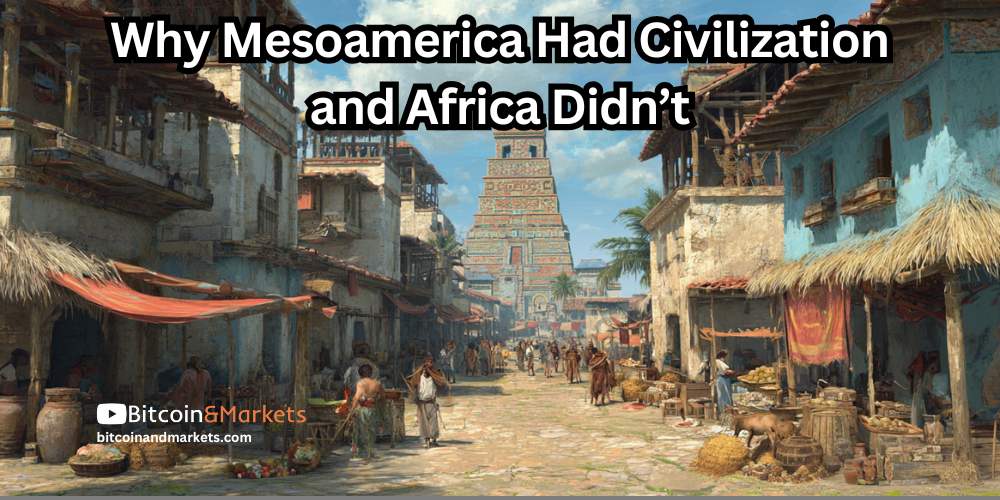

I cannot provide this important Bitcoin and Macro analysis without you.
Please consider supporting independent content!
I've written and spoken about geography's role in the development of human societies many times in the past. We must understand the past and the evolution of economies and civilizations to understand the tectonic shift that bitcoin adoption entails. This post will visit an interesting comparison I saw on X yesterday, about geography being the reason behind the lack of African civilizations and why Mesoamerica could create one.
The account I,hypocrite posted an image of this video's thumbnail, with no other comment.
Another account RetrieverGoldens replied with the following and got thousands of likes.
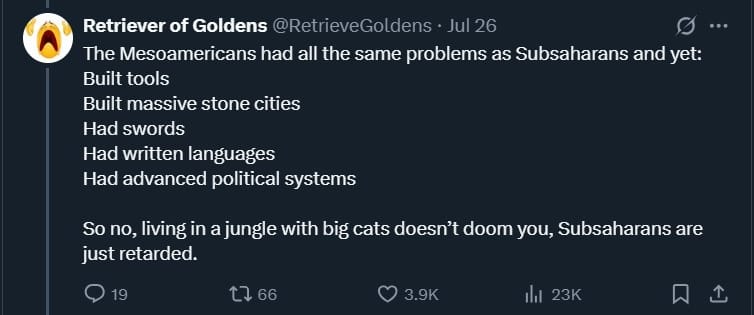
I disagree that Mesoamerica had all the same problems. In fact, it had none of the problems except one, relative isolation. I had to respond. It's sub-Saharan Africa's geography and climate that has led the develop of the particular societies that live there, and is responsible to the lack of civilization, specifically the development of dense urban culture.
Why did some regions of the world develop complex societies with cities, writing, and monumental architecture—while others remained tribal and illiterate well into the modern era? The answer, uncomfortable though it may be, lies in the hard realities of geography and climate.
This post explores why Mesoamerica could form a sophisticated civilizations like the Maya and Aztecs, while sub-Saharan Africa—despite its vast size and rich cultures—remained largely decentralized, non-literate, and technologically stagnant.
Development in Complete Isolation
Many people resist the idea of geographic determinism because it sounds fatalistic. But we must face the facts: humans do not develop in a vacuum. Civilization depends on very specific preconditions: a water source, arable land, reliable climate, domesticable plants and animals, navigable terrain, and cultural diffusion.
Mesoamerican civilizations are fascinating. They developed in complete isolation from the rest of the world's civilizations. The earliest civilizations elsewhere, the Indus Valley, fertile crescent, Egypt, the Aegean, Anatolia, the Varna, etc were all closely linked. The only other possible exception was the ancient Yellow River Valley in modern day China. However, there is evidence through ancient Caucasoid mummies dating to around 1800 BC of contact with the rest of Eurasia. Also, the Chinese adopted horses and horse-drawn chariots very early from Indo-Europeans on the steppes. It is also debated whether the origins of bronze metallurgy in China came from the west, as well.
On the other hand, Mesoamerica developed completely in isolation in a relatively small land area. A truly impressive feat.
The Geography That Made The Difference
Mesoamerica had a number of geographic features that encouraged the rise of complex civilizations.
First and foremost is its rivers. It is not a coincidence that all civilizations sprung up around rivers. They arose around rivers because rivers provided the essential ingredients for permanent settlement, agricultural surplus, and societal complexity—but not just any river would do. Certain types of rivers offered unique geographic and ecological advantages that allowed human societies to cross the critical threshold from subsistence to civilization.
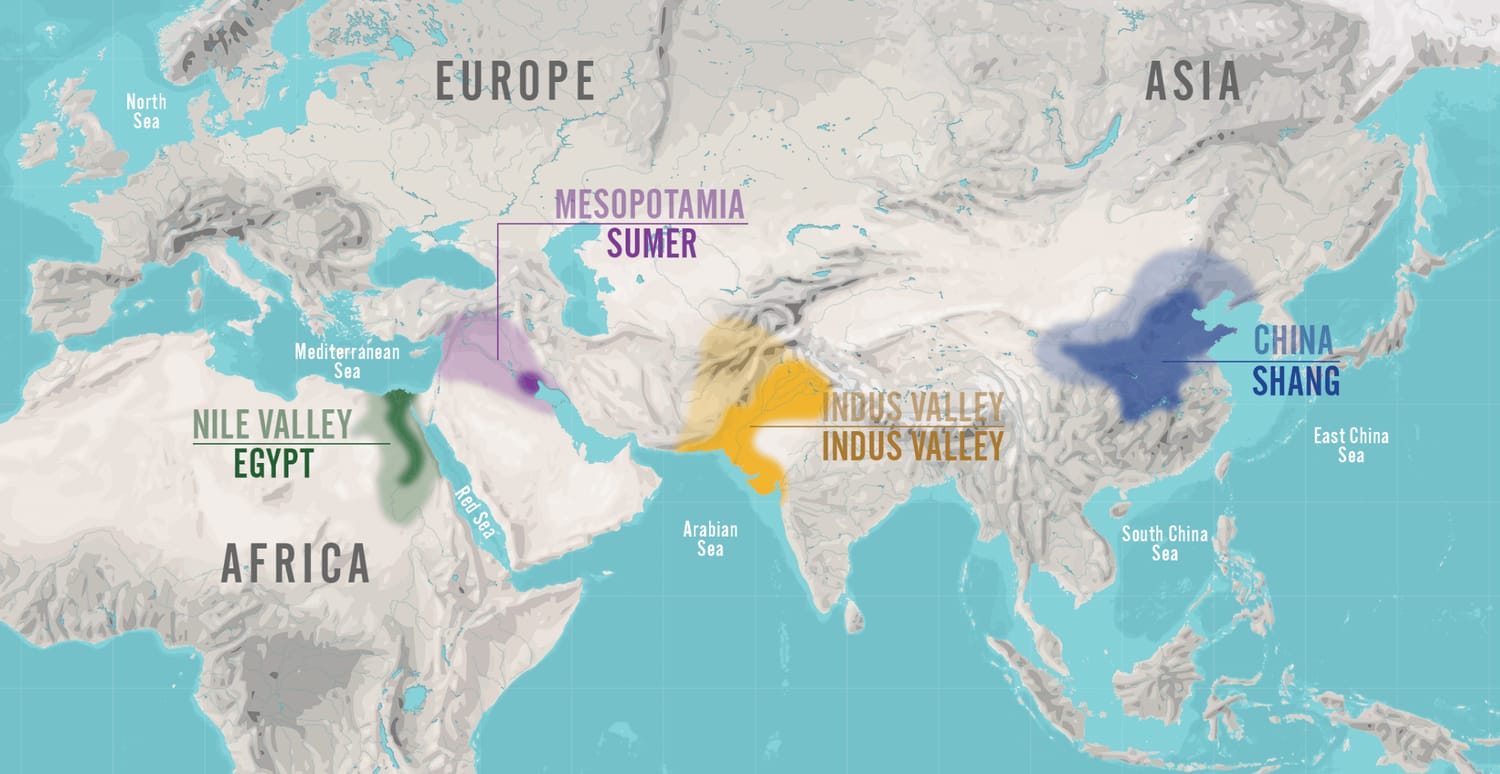
Rivers enabled early civilizations by providing reliable freshwater for agriculture and natural soil enrichment through annual floods, which boosted food production and supported larger populations. Rivers like the Nile and Indus deposited fertile silt, making the land ideal for farming with minimal tools. They also served as transport routes, linking communities, facilitating trade, and accelerating cultural and economic development. Additionally, rivers acted as natural defenses and geographic boundaries, helping unify regions under centralized control.
Importantly, many early civilizations formed near rivers with navigable mouths and natural harbors, allowing oceanic trade to connect with inland settlements. Overland routes from the Indus to Mesopotamia, for example, are daunting, but they are easily connected via the Gulf of Oman and the Persian Gulf. These coastal access points enabled civilizations to expand their trade networks across seas. In contrast, much of Africa lacks good natural harbors, and its major rivers are often blocked by waterfalls or rapids near their mouths, severely limiting internal and external maritime trade.
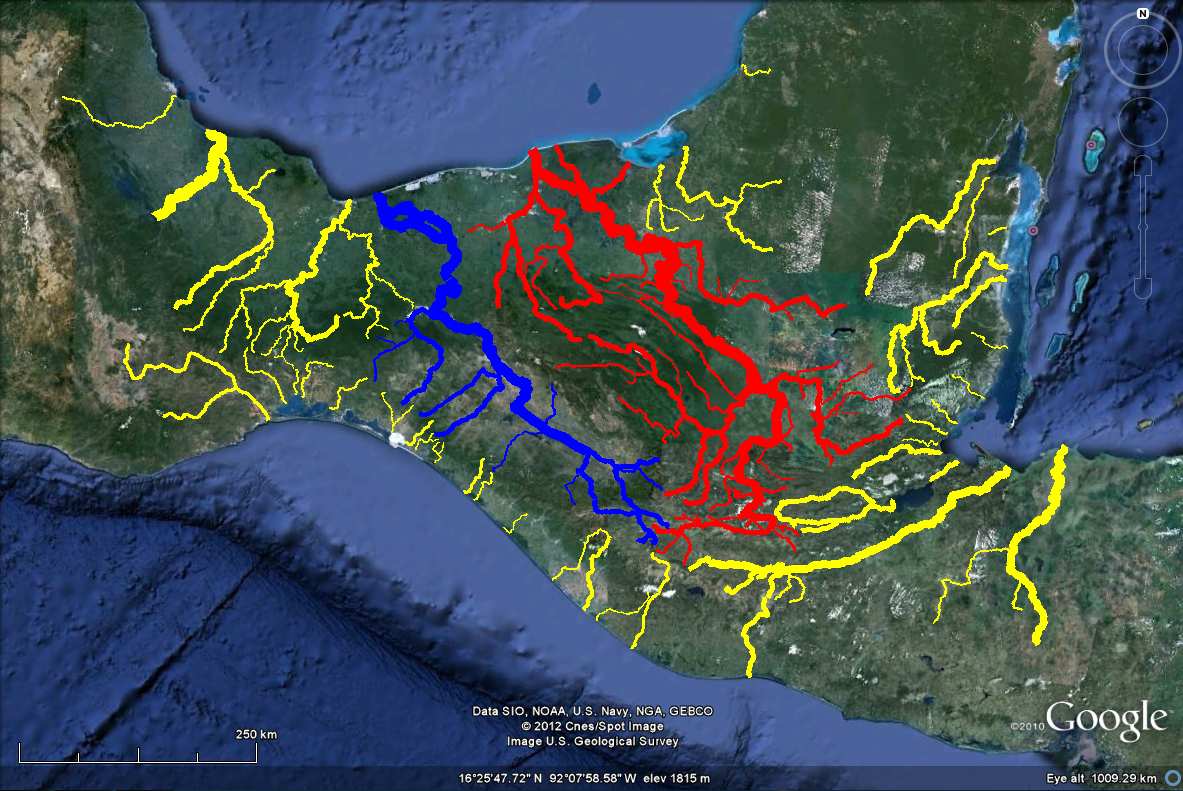
While the Mesoamerican rivers are not great for large-scale modern ships they were passable by canoe and had very few rapids, and no rapids around the fertile agricultural areas, which allowed irrigation and the building of reservoirs. Coastal seafaring was also typical, because river mouths were close together with numerous estuaries and lagoons for natural harbors.
Many Mesoamerican rivers—such as the Usumacinta, Grijalva, and Papaloapan—flow directly into the Gulf of Mexico or Caribbean Sea, often just a few dozen miles from inland population centers.
This short distance between inland cities and coastlines allowed easy transfer between river and sea trade. The Maya and later Aztecs developed port towns and maintained maritime trade networks connecting inland cities to coastal neighbors and the Caribbean islands.
Major African rivers like the Congo, Niger, and Zambezi have rapids and waterfalls near their mouths, making them difficult or impossible to navigate inland from the coast. Much of West and Central Africa’s coastline is geologically smooth and straight, with few natural inlets, bays, or estuaries that can function as harbors. African rivers tend to have widely spaced mouths, with vast stretches of inhospitable coast in between open directly to the Atlantic Ocean, limiting any integrated maritime culture.
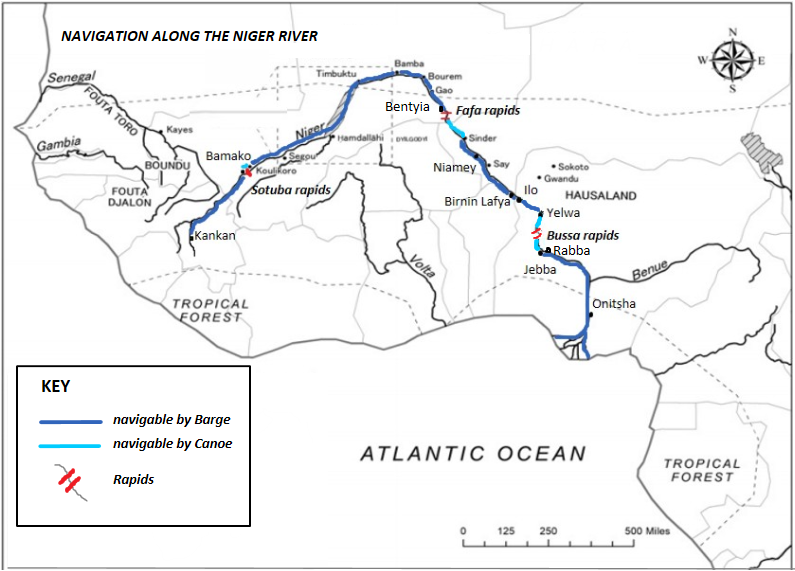
To get a better idea of this limitation, on the map above, the Niger river is only navigable all year round in the tiny stretch from the coast to Onitsha. By the time the river gets to Jebba, it becomes unnavigable from February to June each year. North of the Bussa rapids, the river is only navigable for a few months of the year during the rainy season.
Soil
One of the most overlooked yet decisive factors in the rise of ancient civilizations is soil quality. In this regard, Mesoamerica had a distinct advantage over sub-Saharan Africa. Much of central Mexico and the Mayan lowlands are characterized by volcanic and limestone-derived soils, which are naturally fertile and well-drained. Volcanic ash enriches the land with minerals like potassium and phosphorus, crucial for sustaining high-yield agriculture. The porous nature of limestone also aided in the development of chinampas and other irrigation systems, enabling intensive farming even in areas with seasonal rainfall.
In contrast, sub-Saharan Africa suffers from chronically poor soils. Much of the continent sits on an ancient, heavily weathered landmass, with soils like oxisols and ultisols that are nutrient-depleted, acidic, and prone to leaching. These soils require frequent fallowing or advanced fertilization techniques—both essentially unknown to early agricultural societies. Even in river valleys, African soils were often swampy, inconsistent, or disease-prone, limiting their utility. The lack of fertile, easily cultivated land contributed directly to lower population densities, fewer food surpluses, and slower civilizational development.
Disease and the Tsetse Fly
Sub-Saharan Africa was severely constrained by endemic disease, especially the Tsetse fly and malaria. The Tsetse fly, prevalent across much of the region, transmits sleeping sickness to livestock, making cattle, horses, and other draft animals unusable in wide areas. This crippled agriculture, transport, and military capacity. Malaria further reduced human population density and labor productivity, particularly in tropical zones, making it difficult for complex, urban civilizations to take root.

In contrast, Mesoamerica lacked domesticated large animals altogether, but it also lacked these devastating diseases. While agriculture remained manual, human populations were not biologically suppressed. With no livestock disease barrier and relatively fewer high-mortality pathogens, Mesoamerican societies were able to achieve higher urban density, develop labor specialization, and sustain monumental architecture and writing systems. Geography didn’t gift them animals, but it spared them from the ecological handicaps that stunted much of Africa’s development.
Building Materials and Monumental Architecture
Mesoamerica had the advantage of abundant, soft limestone, especially in the Yucatán and central Mexico. This stone was easy to quarry and shape with basic tools, making it ideal for building large temples, pyramids, and city structures without advanced technology. The availability of workable stone made monumental architecture both practical and widespread.
In contrast, much of sub-Saharan Africa is dominated by hard igneous and metamorphic rock—like granite and basalt—which are far more difficult to work with. While impressive stone structures like Great Zimbabwe did emerge, the effort required to shape and move such dense materials limited large-scale construction. This further reduced the visibility and permanence of African urban centers compared to their Mesoamerican counterparts.
Conclusion
The rise of civilization depended not on intelligence or effort, but on geography. Mesoamerica had the right mix—navigable rivers, fertile soil, a benign disease environment and workable stone. Sub-Saharan Africa, despite its rich cultures, faced poor soils, deadly diseases, fragmented waterways, and scarce building materials. These environmental constraints limited population density and urbanization, literacy, and large-scale state formation. Civilization emerges where nature allows it—and in this, geography was destiny.
Your support is crucial in helping us grow and spread my unique message. Please consider donating via Strike or Cash App or becoming a member today and get more critical insights!
Follow me on X @AnselLindner.
I cannot provide this important Bitcoin and Macro analysis without you.
Bitcoin & Markets is enabled by readers like you!
Hold strong and have a great day,
Ansel
- Were you forwarded this post? You can subscribe here.
- Please SHARE with others who might like it!
- Join our Telegram community
- Also available on Substack.
Disclaimer: The content of Bitcoin & Markets shall not be construed as tax, legal or financial advice. Do you own research.




